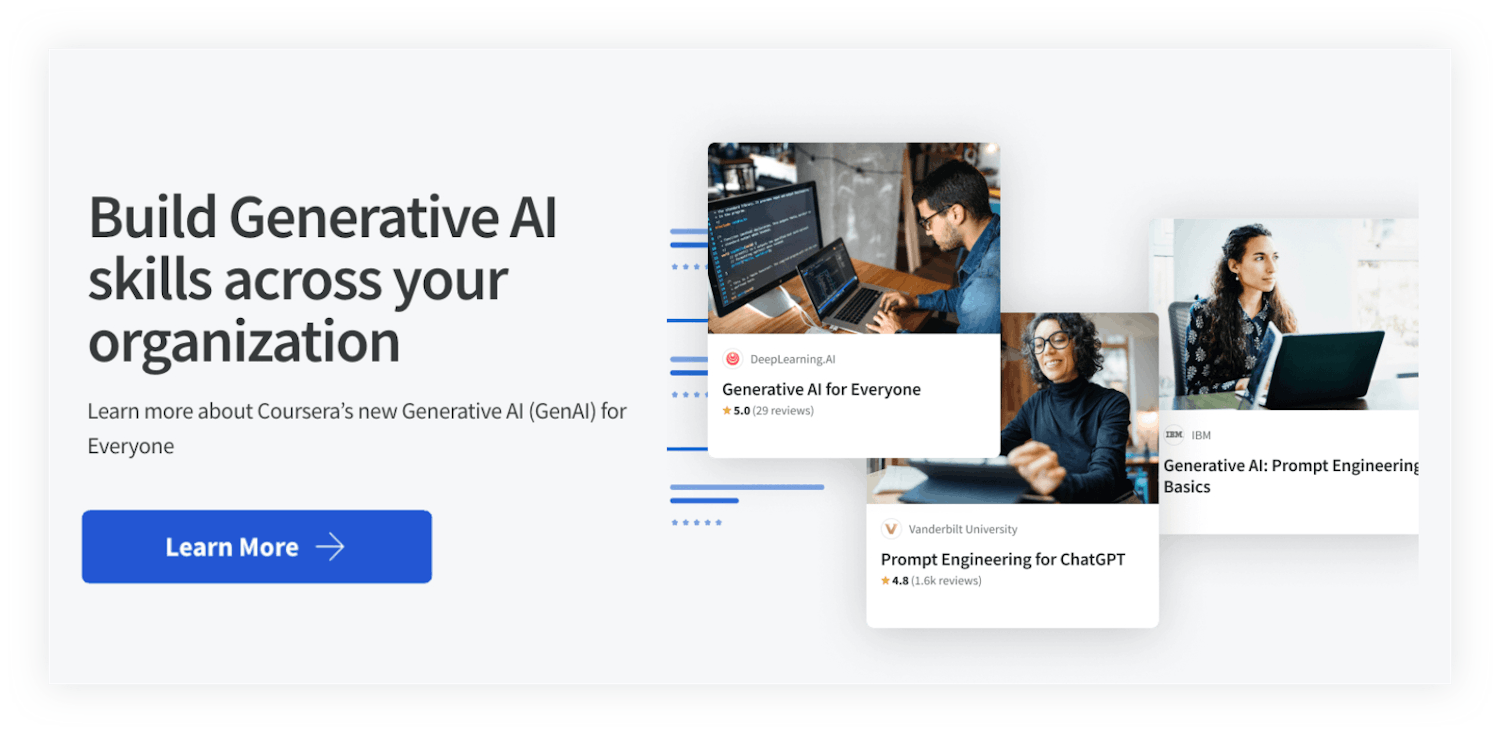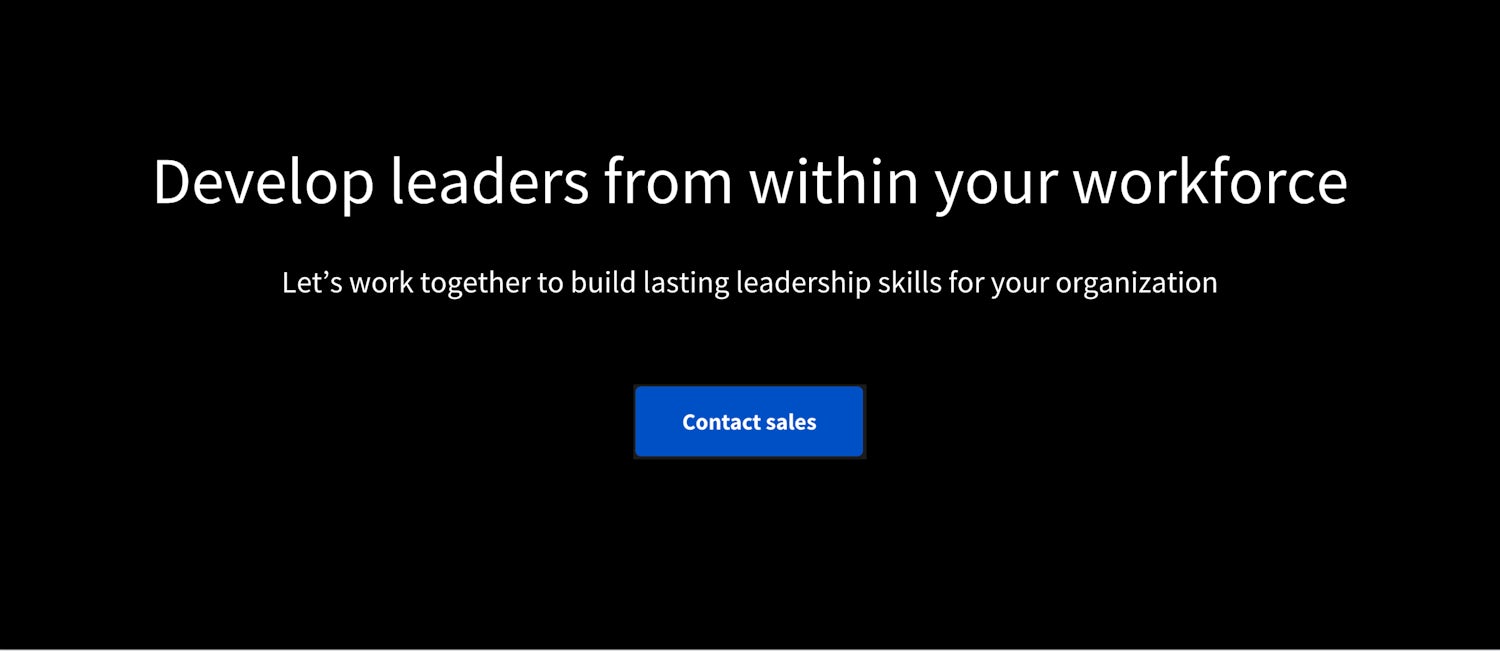AI Career Paths: Training Your Team to Become AI Leaders
Embrace the rise of artificial intelligence and empower your team to unlock opportunities and find solutions that work for your company.
![[Featured Image] A woman sits at a computer and learns about using artificial intelligence to benefit her career.](https://d3njjcbhbojbot.cloudfront.net/api/utilities/v1/imageproxy/https://images.ctfassets.net/wp1lcwdav1p1/0dtktfkUoYJVLeo5SQVQA/8a4f8f95b28ad9e569e60f06fbcc2bb9/GettyImages-613861364.jpeg?w=1500&h=680&q=60&fit=fill&f=faces&fm=jpg&fl=progressive&auto=format%2Ccompress&dpr=1&w=1000)
Artificial intelligence (AI) has immense potential to transform how we do business and deliver products and services to customers. In fact, it has already enhanced how we use social media, banking, online shopping, and smart devices. Powered by algorithms, teams can incorporate AI into their workflow to make processes more efficient.
Leaders, in turn, can empower team members to experiment with AI, adopting a growth mindset to play with generative AI to find solutions. They can inspire team members and colleagues to embrace AI and develop leadership skills.
In this article, we’ll take you through how to pursue an AI career path and train your team in AI, by starting where you are, incorporating AI into your team, and developing the skill set to pursue this in-demand discipline.
Start your AI career path from where you are
With AI growing in popularity and tools like ChatGPT spreading its public use, there are plenty of opportunities to incorporate AI into your career. Start by doing some research. If your company is open to experimenting with AI tools, use them to enhance your everyday work, whether you are in UX design, marketing, or finance.
As a leader, adopt a growth mindset. Empower your team to experiment with AI tools. Get up to speed on industry knowledge. Eventually, you could open a role on your team devoted to AI, such as an AI trainer, prompt engineer, or content creator.
On the flip side, if you’re a team member interested in pursuing AI as a career path, you can start defining your trajectory by using AI on your team. Then, decide what function or role you’d like to play in AI. What roles in AI are out there? Do you have transferable skills? Start conducting informational interviews with people in roles you find interesting.
How to incorporate AI in your career
A good place to start pivoting your career toward AI is to incorporate it into your current work. This is a helpful tactic for getting into any discipline but is especially relevant to AI as it is being embraced in media across industries.
Not all AI tools are created equal. If you’re a graphic or industrial designer or in a role where you need to craft creative concepts from scratch, experiment with the AI image generator DALL-E. If you’re a content writer, you might use ChatGPT to jog your memory as a brainstorming tool.
Start with generative AI
AI powers the machine learning algorithms behind your Spotify listening, but generative AI uses inputted data to create outputs based on prompts. With generative AI, you can engineer prompts to achieve your exact desired output.

Read more: What Is Prompt Engineering? Definition and Examples

Examples of AI at work
To give you some ideas on how specific functions use AI across different industries, take a look at these examples.
Automating tasks: AI can automate tasks that are repetitive and nearly impossible for employees to do manually. This frees up time for employees to work on more complex, creative, and enjoyable tasks. In customer service departments, AI chatbots simulate the experience of speaking to a real agent to handle simple customer inquiries and requests.
Analyzing data and making decisions: Algorithms can be programmed to collect, sort, and analyze large amounts of data quickly and accurately. Data scientists and business analysts can use this data to devise insights and patterns that drive business decisions. Data is often used in risk analysis, market research, trends forecasting, and more, across industries as wide-ranging as health care, retail, and media.
Personalization: You may be familiar with Netflix’s ability to suggest what television show you might want to watch next. AI can personalize experiences by analyzing your behavior and preferences to provide recommendations. While this is most common with streaming services and online shopping, social media marketers can also track your data to Instagram, for example, to serve you recommendations based on your recent online searches.
Consider your role and your team’s mission to decide whether you can incorporate AI into your daily tasks.
How to train your team to become AI leaders
Now, you’re probably wondering how to develop your skills to prepare you and your team for the future of AI. Here’s a step-by-step guide to leading the charge toward AI to train your team members, including how to empower them to pursue AI in their current role or in their careers, to become AI leaders.
1. Be open-minded to artificial intelligence
To fully embrace artificial intelligence, it’s necessary to develop workplace skills, also known as soft skills. You might encourage your team to take courses or workshops in the following areas:
Adaptability
Creativity
Critical thinking
Empathy
Leadership
Organization
Problem-solving
Resourcefulness
Strategic thinking
Teamwork
As a leader, you can set a good example for your team. Building soft skills is effective for team building, as it fosters trust, enabling innovation and creativity.
Being open to AI requires teams to experience failure and setbacks–sometimes, tinkering with the right prompt for ChatGPT requires more energy than a brainstorming session. But sometimes, finding an AI-powered solution to data insights could unlock a product’s future.
2. Experiment with AI tools
Allow your team to experiment with AI tools. Following the development of workplace skills and a growth mindset, you can encourage problem-solving with the help of AI.
Zoom AI Companion: AI-powered features for video conferencing that can summarize meetings in real time, as well as initiate brainstorming sessions based on prompts using a whiteboard tool. It can then draft emails based on those conversations and develop future meeting agendas, all from collecting data from the chat and meeting.
ChatGPT: Input a prompt in ChatGPT to start off a content marketing draft outline, or input a document and ask ChatGPT to summarize it. The possibilities are endless, though it may require some time to input and prompt the GPT-4 model to deliver what you want. This can be used across departments and industries.
Canva Pro: While there are other AI generators, such as DALL-E, that can generate images, Canva Pro takes that a step further to help you create flyers, presentations, and social media posts. Like its regular, non-AI version, Canva Pro has AI-driven tools that can edit, erase, and design as you wish.
Otter.ai: Eliminate the tedium of transcribing interviews and meetings with Otter.ai, which lets you import an audio recording and will transcribe it for you in just a few minutes.
With IBM's AI Product Manager Professional Certificate, you can learn to apply your leadership skills to the AI product management lifecycle. You'll examine real-world case studies of successful AI integration and develop or strengthen your knowledge of Agile concepts and methodologies. By the end, you'll have earned a Professional Certificate from an industry leader in technology.
Read more: What Is Generative AI? Definition, Applications, and Impact
3. Develop AI skills for your industry or sector
Next, you’ll want to develop the appropriate AI skills for your industry or sector. Whether you’re infusing your work with AI tools or jumping into a career switch, here are some primary skills to know–and some courses that apply AI to business, education, and health care.
Technical AI skills
Programming languages such as Julia, Python, C++, and Javascript
Math, including statistics and algebra
Read more: 5 In-Demand Jobs Requiring AI Skills
AI courses by industry
• Business: UPenn Wharton's AI for Business Specialization
• Teaching: Macquarie University’s Artificial Intelligence (AI) Education for Teachers
• Healthcare: Stanford’s AI in Healthcare Specialization

4. Be aware of AI bias and ethics
As you develop AI skills and start incorporating them into your workflow, be aware of potential breaches of bias and ethics. For example, people who use ChatGPT to upload transcripts, interviews, documents, and more, need to scrub the data for names and identifying information. If not, that information can be used to “learn” from and become a breach of privacy.
Anytime technology deals with personal information and large amounts of data, there is a potential for bias. This occurs in human resources, when recruiters may be unaware that their applicant tracking systems (ATS) are unintentionally programmed to filter candidates based on certain factors that may be discriminatory. While measures are taken to mitigate such risks, AI is susceptible to human error and is imperfect.
Read more: AI Ethics: What It Is and Why It Matters
5. Apply your skills to an AI career path
If you’re interested in switching to AI or developing an AI-focused role on your team, then do some research into job roles such as AI engineer, machine learning engineer, robotics engineer, and data scientist.
For more niche roles, you may also want to look into roles such as AI compliance manager, AI ethicist, prompt engineer, and tech start-up founder.
Read more: 6 Artificial Intelligence (AI) Jobs to Consider in 2024

Keep reading
Coursera Staff
Editorial Team
Coursera’s editorial team is comprised of highly experienced professional editors, writers, and fact...
This content has been made available for informational purposes only. Learners are advised to conduct additional research to ensure that courses and other credentials pursued meet their personal, professional, and financial goals.